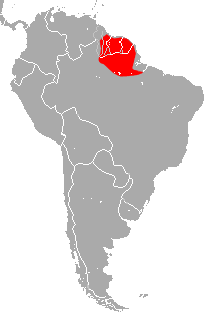Amazonian sac-winged bat: Difference between revisions
ShortDescBot (talk | contribs) ShortDescBot adding short description "Species of bat" |
m Task 19: convert/update IUCN references to {{cite iucn}} using data from IUCN Red List API; IUCN status confirmed; IUCN status ref updated; (2/00:03.57); |
||
| Line 4: | Line 4: | ||
| status = DD |
| status = DD |
||
| status_system = IUCN3.1 |
| status_system = IUCN3.1 |
||
| status_ref = <ref name=iucn>{{cite iucn| |
| status_ref = <ref name="iucn status 19 November 2021">{{cite iucn |author=Sampaio, E. |author2=Lim, B. |author3=Peters, S. |date=2016 |title=''Saccopteryx gymnura'' |volume=2016 |page=e.T19806A22005356 |doi=10.2305/IUCN.UK.2016-2.RLTS.T19806A22005356.en |access-date=19 November 2021}}</ref> |
||
| genus = Saccopteryx |
| genus = Saccopteryx |
||
| species = gymnura |
| species = gymnura |
||
| Line 12: | Line 12: | ||
}} |
}} |
||
The '''Amazonian sac-winged bat''' (''Saccopteryx gymnura'') is a [[bat]] [[species]] of the family [[Emballonuridae]] from [[South America]].<ref name = "Simmons">{{MSW3 Chiroptera | id = 13801046 | page = 391}}</ref> It is found in northern [[Brazil]], [[Guyana]], [[French Guiana]], [[Suriname]] and possibly [[Venezuela]].<ref name=iucn/> |
The '''Amazonian sac-winged bat''' (''Saccopteryx gymnura'') is a [[bat]] [[species]] of the family [[Emballonuridae]] from [[South America]].<ref name = "Simmons">{{MSW3 Chiroptera | id = 13801046 | page = 391}}</ref> It is found in northern [[Brazil]], [[Guyana]], [[French Guiana]], [[Suriname]] and possibly [[Venezuela]].<ref name="iucn status 19 November 2021" /> |
||
==Taxonomy and etymology== |
==Taxonomy and etymology== |
||
| Line 22: | Line 22: | ||
==Biology and ecology== |
==Biology and ecology== |
||
It is [[insectivore|insectivorous]], catching its prey in the air.<ref name=iucn/> |
It is [[insectivore|insectivorous]], catching its prey in the air.<ref name="iucn status 19 November 2021" /> |
||
==Range and habitat== |
==Range and habitat== |
||
This bat inhabits humid [[tropical rainforest|tropical forests]]. |
This bat inhabits humid [[tropical rainforest|tropical forests]]. |
||
It is found in several countries and territories in northern [[South America]], including [[Brazil]], [[French Guiana]], [[Guyana]], and [[Suriname]].<ref name=iucn/> |
It is found in several countries and territories in northern [[South America]], including [[Brazil]], [[French Guiana]], [[Guyana]], and [[Suriname]].<ref name="iucn status 19 November 2021" /> |
||
==Conservation== |
==Conservation== |
||
It is currently evaluated as [[data deficient]] by the [[IUCN]]. |
It is currently evaluated as [[data deficient]] by the [[IUCN]]. |
||
It is uncommonly encountered and its range is not clearly defined.<ref name=iucn/> |
It is uncommonly encountered and its range is not clearly defined.<ref name="iucn status 19 November 2021" /> |
||
==References== |
==References== |
||
Revision as of 06:16, 19 November 2021
| Amazonian sac-winged bat | |
|---|---|
| Scientific classification | |
| Domain: | Eukaryota |
| Kingdom: | Animalia |
| Phylum: | Chordata |
| Class: | Mammalia |
| Order: | Chiroptera |
| Family: | Emballonuridae |
| Genus: | Saccopteryx |
| Species: | S. gymnura
|
| Binomial name | |
| Saccopteryx gymnura | |

| |
| Amazonian sac-winged bat range | |
The Amazonian sac-winged bat (Saccopteryx gymnura) is a bat species of the family Emballonuridae from South America.[3] It is found in northern Brazil, Guyana, French Guiana, Suriname and possibly Venezuela.[1]
Taxonomy and etymology
It was described as a new species in 1901 by British zoologist Oldfield Thomas.[2] Thomas identified "Mr. Wickham" as the collector of the holotype, possibly referring to British explorer Henry Wickham who also collected bird specimens in South America.[4] Wickham collected the holotype in Santarém along the Amazon River.[2] The species name "gymnura" is from Ancient Greek "gumnós" meaning "naked" and "ourá" meaning "tail." Thomas wrote, "the nakedness of the interfemoral [membrane] will readily distinguish this bat from any of its allies."[2]
Biology and ecology
It is insectivorous, catching its prey in the air.[1]
Range and habitat
This bat inhabits humid tropical forests. It is found in several countries and territories in northern South America, including Brazil, French Guiana, Guyana, and Suriname.[1]
Conservation
It is currently evaluated as data deficient by the IUCN. It is uncommonly encountered and its range is not clearly defined.[1]
References
- ^ a b c d e Sampaio, E.; Lim, B.; Peters, S. (2016). "Saccopteryx gymnura". IUCN Red List of Threatened Species. 2016: e.T19806A22005356. doi:10.2305/IUCN.UK.2016-2.RLTS.T19806A22005356.en. Retrieved 19 November 2021.
- ^ a b c d Thomas, O. (1901). "New species of Saccopteryx, Sciurus, Rhipidomys, and Tatu from South America". The Annals and Magazine of Natural History; Zoology, Botany, and Geology. 7. 7 (39): 367–368.
- ^ Simmons, N.B. (2005). "Order Chiroptera". In Wilson, D.E.; Reeder, D.M (eds.). Mammal Species of the World: A Taxonomic and Geographic Reference (3rd ed.). Johns Hopkins University Press. p. 391. ISBN 978-0-8018-8221-0. OCLC 62265494.
- ^ Sclater, P. L. & Salvin, O. (1867). "List of birds collected on the Blewfields River, Mosquito Coast, by Mr. Henry Wickham". Proceedings of the Zoological Society of London. 1867: 278–280.

